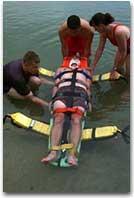September 30, 2016 Meeting the Standard of Care for Spinal Injuries
Reprinted from Aquatics International Magazine (September/October 1998)
by Gerald M. Dworkin

Properly recognizing and managing suspected spinal injuries caused by head-first entries into the water require high levels of training. Lifeguards and other water rescue personnel must be able to evaluate the signs and symptoms associated with spinal trauma and the manner in which an injury occurs. The rescuer should assume that a spinal injury exists if the forces causing the trauma were sufficient to damage the spine.
When a spinal injury occurs, the rescuer must immediately restrict the victim’s spinal motion to prevent further injury. Principles of spinal-motion restriction should include:
- Manual motion restriction of the head and neck while assessing the ABC’s (airway, breathing, circulation);
- Placement of the head and neck in a neutral position when possible and not contraindicated; and
- Immobilization on a rigid spine board, with the use of an appropriately sized cervical extrication collar, a cervical immobilization device (CID) to anchor the head to the board, and an appropriate strapping system to secure the body to the board.
Procedural Changes
Training courses for emergency medical services (EMS), first responders and lifeguards have advocated the above principles for the past 20 years. Yet, with the release of the 1995 American Red Cross lifeguard training programs, the Red Cross abandoned these principles and now advocates that spinal immobilization in the water be accomplished by as few as two lifeguards using a rigid board with a commercial head immobilizer and a sub-standard strapping system, and without the use of a cervical extrication collar.
I believe that the procedures advocated by the Red Cross do not meet the standard of care dictated by the EMS community, and that these procedures are not only dangerous, but can actually increase the severity of the injury.
A 1988 study identifies secondary spinal-cord injuries as significant sources of major neurological deficits (Paraplegia, 26:143-150). Improper handling and transportation techniques by pre hospital personnel may be responsible for up to 10 percent of these secondary injuries. It’s possible that the procedures advocated by the Red Cross could be responsible for an increase in secondary injuries during the rescue phase.
The procedures currently advocated by the Red Cross should be exception, not the standard. I encourage the Red Cross to modify its position as follows:
- Advocate rescue procedures that require the use of at least three rescue personnel. Rescuer One maintains the patient’s head and neck in neutral alignment throughout the rescue. Rescue Two maintains the backboard afloat, stable, and horizontal. Rescuer Three immobilizes the patient to a rigid backboard. In situations where appropriately trained personnel are not available, the Red Cross should advice that the patient be supported in the water until appropriate EMS personnel arrive.
- To provide adequate in-line stabilization and support, require a rigid backboard, a CID, and an appropriately sized and applied cervical extrication collar. A CID should be used in conjunction with an appropriately sized collar; the CID should not replace the need for the cervical collar, and vice versa.
- For appropriate immobilization, require the use of an effective strapping system that prohibits lateral, anterior (up from the board), and head-to-foot movement. The strapping system advocated by the Red Cross — three straps placed laterally across the patient — does not accomplish this, especially if the patient needs to be turned on his/her side to clear the airway. I recommend two straps placed diagonally across the patient’s chest, with one anchor point directly over each shoulder and the other anchor point just below each armpit. Additionally, at least three, recommended four, straps should be placed laterally across the patient at the torso, hips, and lower extremities.
Better Training and Equipment.
The American Red Cross rationalizes that it has excluded instruction on the use of cervical collars because (a) many facilities don’t have collars of different sizes; (b) lack of in-service training results in degradation of skills; and (c) lack of available staff results in backboarding being a two-person task.
This rationale should not be an excuse to eliminate the instruction and use of established safety procedures. A complete set of six collars costs approximately $72, a small price to pay when considering the true value of the collars. Additionally, the Red Cross should call for an increase in the education and training of lifeguards through formal programs and in-service training.
The advances in pre hospital equipment, education and training have reduced the number and severity of spinal cord injuries. Only through the availability of appropriate spinal immobilization equipment and the effective training of lifeguard and other rescue personnel can we continue to reduce the number and severity of water-related spinal cord injuries.


